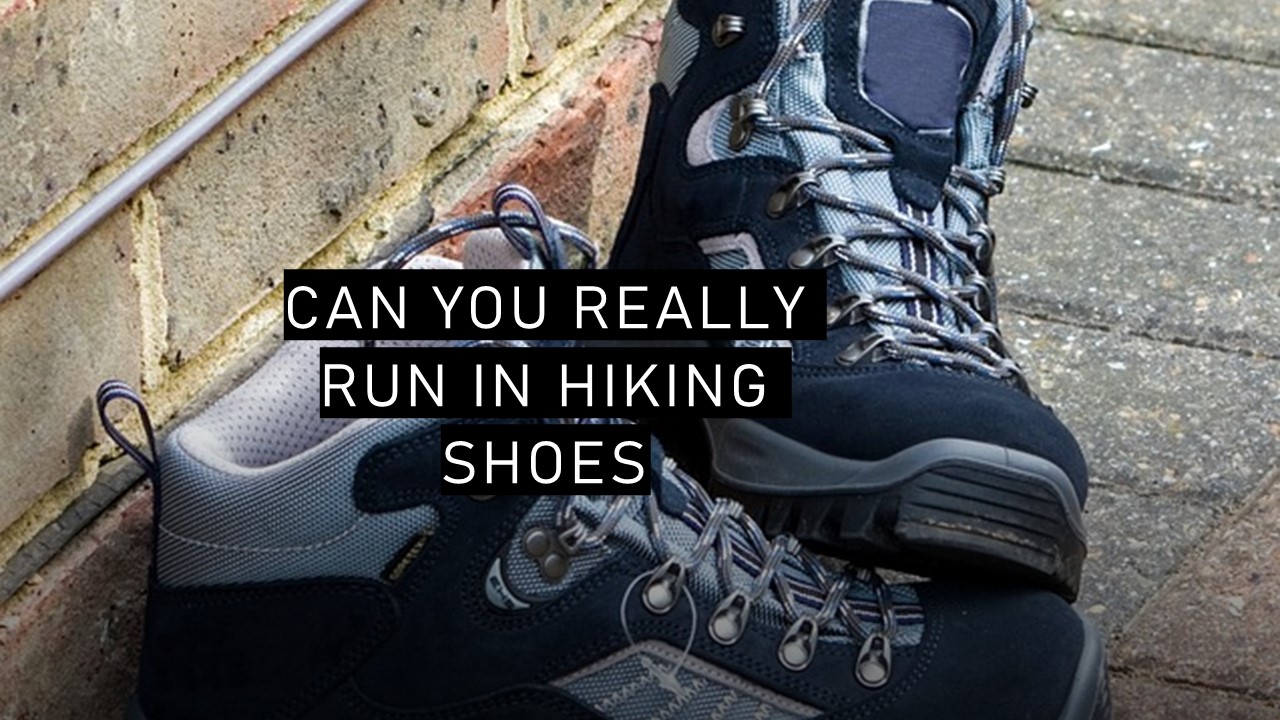Hey there! If you’ve ever found yourself torn between the idea of running in your trusty hiking shoes, you’re not alone. Today, I’m going to tackle the burning question: Can you run in hiking shoes? As someone who loves exploring the great outdoors and occasionally breaking into a jog, I understand the curiosity and desire to find versatile footwear.
The answer is yes, it is possible to run in hiking shoes. However, it’s important to consider factors such as personal comfort, terrain, and distance. While hiking shoes offer stability and protection, they may not provide the same performance benefits as running shoes designed specifically for running activities. Ultimately, it’s a matter of individual preference and the specific demands of your run.
In this guide, I will uncover some valuable insights and discover if your hiking shoes can be your go-to running companions. Let’s get started!
Understanding the Differences Between Hiking Shoes and Running Shoes
Before I dive deep into the topic of running in hiking shoes, let’s take a moment to understand the key differences between these two types of footwear. Hiking shoes are specifically designed to provide stability, support, and durability for treks through rugged terrains while running shoes are built for speed, agility, and cushioning on pavement or tracks.
Hiking Shoes: Hiking shoes are known for their sturdy construction, built to withstand the challenges of hiking trails. They typically feature a robust design with strong ankle support, providing stability on uneven surfaces. The materials used in hiking shoes are often durable and resistant to abrasion, protecting your feet from rocks, roots, and other obstacles along the trail.
Running Shoes: On the other hand, running shoes are designed to optimize your performance while running. They prioritize lightweight materials, allowing for swift movement and reduced fatigue. The cushioning systems in running shoes aim to absorb impact and provide a responsive feel. Additionally, they often incorporate breathable and flexible materials to enhance comfort during long runs.
Now that you have a clearer understanding of the characteristics that distinguish hiking shoes from running shoes, let’s explore whether hiking shoes can actually provide the comfort and performance needed for running. After all, you wouldn’t want anything holding you back from enjoying your outdoor adventures to the fullest.
Can Hiking Shoes Be Comfortable for Running?
Absolutely! While hiking shoes and running shoes have different designs and purposes, it doesn’t mean that you can’t find comfort in hiking shoes while running. Comfort is subjective and can vary from person to person, so let’s dive into the factors to consider when assessing the comfort of hiking shoes for running.
- Personal Comfort Preferences: Everyone has different preferences when it comes to footwear. Some individuals may find the sturdiness and ankle support of hiking shoes to be comforting during their runs, while others may prefer the lighter weight and flexibility of running shoes. It’s important to listen to your body and choose what feels best for you.
- Terrain and Running Surface: Consider the type of terrain you’ll be running on. If you’re planning to hit the trails or navigate uneven surfaces, the traction and stability provided by hiking shoes may make your run more comfortable. However, if you’re running on smooth pavements or tracks, the cushioning and responsiveness of running shoes might be more suitable.
- Distance and Intensity of the Run: The distance and intensity of your run can also impact comfort. For shorter and less intense runs, hiking shoes can often provide sufficient comfort and support. However, for longer distances or more demanding workouts, the lighter weight and superior cushioning of running shoes might be beneficial in reducing foot fatigue.
When assessing the comfort levels of hiking shoes for running, pay attention to the following aspects:
- Arch Support and Foot Stability: Hiking shoes often offer good arch support and stability, which can be beneficial for runners with overpronation or flat feet. However, those with high arches may find the support excessive and prefer the flexibility of running shoes.
- Cushioning and Impact Absorption: Hiking shoes typically have thicker and firmer soles to protect against rough terrain. While this can provide excellent shock absorption on trails, it may not offer the same level of cushioning as running shoes, especially for runners who prefer a more plush feel.
- Breathability and Moisture Control: Running can make your feet sweat, so consider the breathability and moisture-wicking properties of the hiking shoes you’re considering. Look for shoes with mesh panels or breathable materials to help keep your feet dry and comfortable during your run.
Remember, finding the right level of comfort is a personal journey. Don’t be afraid to try running in your hiking shoes on shorter runs or less demanding trails to see how they feel. Experimentation and listening to your body will ultimately guide you in deciding if hiking shoes can provide the comfort you need for your running adventures.
Performance Considerations: Running in Hiking Shoes
When it comes to running in hiking shoes, it’s essential to consider the performance aspects that may impact your overall running experience. While hiking shoes are not specifically designed for running, they can still offer certain benefits and drawbacks that influence your performance. Let’s delve into the key performance considerations when running in hiking shoes:
- Impact on Speed and Agility: Hiking shoes are generally bulkier and heavier compared to running shoes, which can affect your speed and agility. The extra weight may slow you down and make quick maneuvers more challenging. If you’re aiming for a faster pace or participating in competitive running, the lighter weight and streamlined design of running shoes may be more conducive to achieving your goals.
- Traction and Grip on Different Surfaces: One advantage of hiking shoes is their exceptional traction and grip on various terrains. The rugged outsoles and deep lugs of hiking shoes provide excellent stability and prevent slipping on uneven surfaces like trails or rocky paths. However, this aggressive tread pattern may feel excessive and impede your stride when running on smooth surfaces like roads or tracks, where the traction isn’t as necessary.
- Impact of Ankle Support on Running Stride: Hiking shoes are designed with higher ankle collars to provide stability and prevent ankle injuries during hikes. While this ankle support can be advantageous on rugged trails, it may limit your ankle’s range of motion during running. Running shoes typically have lower ankle collars, allowing for a more natural and unrestricted running stride. If you prefer a greater range of motion in your ankle while running, hiking shoes may not be the ideal choice.
- Injury Risk and Foot Fatigue: Running shoes are specifically engineered to absorb impact and reduce the strain on your feet and lower limbs. They often incorporate cushioning systems that provide shock absorption, protecting your joints from the repetitive impact of running. Hiking shoes, while they offer durability and protection, may not have the same level of cushioning and shock absorption as running shoes. This could potentially increase the risk of foot fatigue or impact-related injuries during longer or more intense runs.
Considering these performance factors, it’s important to assess your running goals and the specific demands of your chosen running activities. While hiking shoes may be less suitable for speed-focused runs or track workouts, they can still be viable options for certain types of running, such as trail running or off-road adventures. Their stability, traction, and protective features can be advantageous when navigating challenging terrains or when ankle support is crucial.
However, if you’re a dedicated runner seeking optimal performance, investing in a pair of specialized running shoes is highly recommended. Running shoes are designed to enhance your running experience, providing the necessary cushioning, responsiveness, and lightweight design that can make a significant difference in your performance and overall comfort.
Ultimately, the decision to run in hiking shoes depends on your personal preferences, the terrain you’ll be running on, and the intensity of your runs. Assess your priorities and goals, and choose the footwear that aligns best with your specific running needs.
When Running in Hiking Shoes Might Be Appropriate
While running shoes are typically the go-to choice for dedicated runners, there are certain scenarios where running in hiking shoes can be appropriate and even advantageous. Let’s explore some situations where lacing up your hiking shoes for a run might make sense:
- Trail Running and Off-Road Terrain: Hiking shoes excel on rugged trails and off-road terrains. If you enjoy trail running and exploring nature’s challenging paths, your hiking shoes can provide the necessary traction, stability, and protection. The sturdy construction and aggressive outsoles of hiking shoes are specifically designed to handle uneven surfaces, rocks, roots, and other trail obstacles.
- Enhanced Ankle Support for Uneven Surfaces: Hiking shoes typically offer greater ankle support and stability compared to running shoes. This can be particularly beneficial when running on uneven or technical terrains that require extra balance and protection against ankle sprains. If you’re venturing onto trails with challenging elevation changes or unpredictable surfaces, the ankle support provided by hiking shoes can be a valuable asset.
- Protection Against Rocks, Roots, and Obstacles: When running on trails, your feet are exposed to various hazards like sharp rocks, protruding roots, or branches. Hiking shoes often feature durable materials and protective elements, such as reinforced toe caps and sturdy uppers, that shield your feet from potential injuries caused by trail debris. If your running route includes rugged environments with potential foot hazards, the added protection of hiking shoes can give you peace of mind.
- Shorter Distances and Recreational Running: For shorter distance runs or casual recreational runs, the choice of footwear becomes more flexible. If you’re planning a moderate-paced jog through a mix of terrain or a light trail run, wearing hiking shoes can be perfectly suitable. The impact on speed and agility may be less noticeable during these types of runs, allowing you to enjoy the versatility of your multi-purpose hiking shoes.
It’s important to note that while hiking shoes can be appropriate in certain scenarios, they may not be ideal for longer distances or high-intensity training runs. Running shoes are specifically designed to optimize performance, provide cushioning, and reduce fatigue during extended periods of running.
If you find yourself frequently engaging in trail running or running in challenging environments, investing in a pair of dedicated trail running shoes might be worth considering to fully enhance your running experience.
Optimal Footwear for Different Activities
Choosing the right footwear for different activities is essential to ensure comfort, performance, and overall foot health. Let’s explore the optimal footwear options for various outdoor activities:
- Hiking: When it comes to hiking, investing in a good pair of hiking shoes or boots is crucial. Look for footwear that offers sturdy construction, ankle support, and durable materials. Hiking shoes are suitable for day hikes on well-maintained trails, while hiking boots provide added ankle support and protection for more rugged or multi-day hikes. Ensure they have good traction and fit comfortably to prevent blisters or discomfort during long hikes.
- Trail Running: For trail running enthusiasts, specialized trail running shoes are the way to go. These shoes are designed with lightweight yet protective features. They offer excellent traction, responsive cushioning, and durable outsoles to handle the demands of uneven terrains. Look for shoes with aggressive tread patterns and toe protection to navigate trails confidently and comfortably.
- Road Running: If you primarily run on paved surfaces like roads or tracks, running shoes designed for road running are the optimal choice. These shoes prioritize lightweight construction, cushioning, and responsiveness. They provide shock absorption, energy return, and a smooth ride on hard surfaces. Look for shoes that offer a good balance of cushioning and support based on your running style and foot biomechanics.
- Walking and Casual Outdoor Activities: For leisurely walks, casual outdoor activities, or everyday wear, comfortable walking shoes or sneakers are ideal. Look for shoes with cushioning, arch support, and a comfortable fit. They should provide adequate flexibility for natural foot movement. Additionally, ensure the shoes have good traction for various surfaces and materials that promote breathability to keep your feet cool and dry.
- Backpacking: When embarking on multi-day backpacking trips, consider backpacking boots. These boots offer robust ankle support, durability, and protection from rugged terrains. They often feature waterproof or water-resistant materials to keep your feet dry in wet conditions. Look for boots with a sturdy sole for stability under heavy loads and ensure they are properly broken in before your trip to prevent blisters and discomfort.
Remember, finding the optimal footwear depends on your individual needs, foot anatomy, and the specific activities you engage in. Prioritize comfort, support, and the demands of the terrain you’ll be encountering. Take the time to try on different options, assess the fit, and consult with knowledgeable professionals to ensure you select the right footwear for each activity.
Conclusion
In conclusion, the question of whether you can run in hiking shoes has been thoroughly explored. While hiking shoes and running shoes have distinct differences in design and purpose, there are situations where running in hiking shoes can be appropriate and comfortable.
When it comes to comfort, personal preferences play a significant role. Factors such as terrain, running surface, and the distance and intensity of your run all contribute to the overall comfort level of running in hiking shoes. Assessing arch support, cushioning, and breathability is essential when determining whether your hiking shoes can provide the comfort you need during your runs.
In terms of performance, hiking shoes may have an impact on speed and agility due to their bulkier and heavier nature. Traction and grip on different surfaces, as well as the influence of ankle support on your running stride, should be considered. Additionally, the potential risk of injury and foot fatigue should be weighed against the protective features and durability of hiking shoes.
There are specific scenarios where running in hiking shoes might be appropriate. Trail running and off-road terrains are well-suited for hiking shoes, given their traction, stability, and protection against obstacles. Similarly, for shorter distances and recreational running, the versatility of hiking shoes can be advantageous.
Ultimately, the optimal footwear for different activities varies based on individual preferences and the specific demands of each activity. Choosing hiking shoes for hiking adventures and investing in specialized running shoes for dedicated running sessions is highly recommended to optimize comfort and performance.
Remember, finding the right footwear is a personal journey. Take into account your comfort needs, running goals, and the specific terrains you’ll encounter. Whether you choose hiking shoes or running shoes, the most important thing is to get out there, enjoy the outdoors, and have a great time on your runs. Happy trails and happy running!
You might also like: The Ultimate Backpacking Food List










